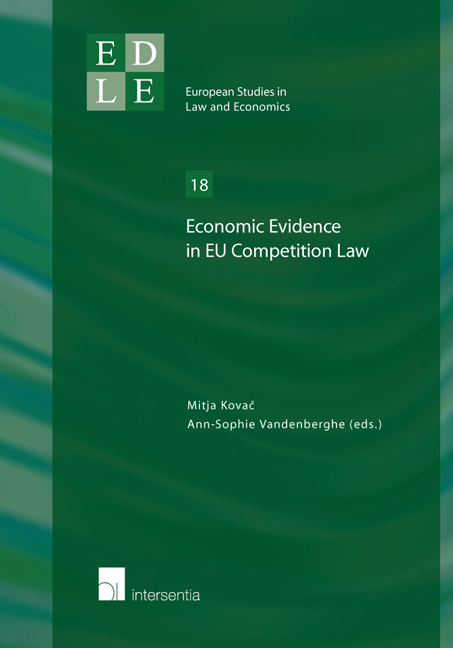Book contents
- Frontmatter
- Dedication
- Preface
- Contents
- List of Contributors
- General Introduction
- PART I ECONOMIC METHODS IN COMPETITION LAW
- PART II ECONOMIC EVIDENCES IN COMPETITION LAW
- Chapter 4 Economic Evidence in Competition Law: The Experience from a National Administrative Court
- Chapter 5 Competition Law and Behavioural Evidence in a Courtroom?
- Chapter 6 Judges, Ex Ante Decisions, Evidence and Proof
- Chapter 7 Law and Economics’ Evidence in Competition Law: Jurisprudence in Slovenia
- PART III INSIDER TRADING, CARTELS AND CRIMINALISATION
- PART IV PRELIMINARY RULINGS AND STATE AID CONTROL
- PART V ECONOMIC EVIDENCE, ENFORCEMENT PROBLEMS AND NATIONAL COURTS
- Index
Chapter 7 - Law and Economics’ Evidence in Competition Law: Jurisprudence in Slovenia
from PART II - ECONOMIC EVIDENCES IN COMPETITION LAW
Published online by Cambridge University Press: 21 September 2018
- Frontmatter
- Dedication
- Preface
- Contents
- List of Contributors
- General Introduction
- PART I ECONOMIC METHODS IN COMPETITION LAW
- PART II ECONOMIC EVIDENCES IN COMPETITION LAW
- Chapter 4 Economic Evidence in Competition Law: The Experience from a National Administrative Court
- Chapter 5 Competition Law and Behavioural Evidence in a Courtroom?
- Chapter 6 Judges, Ex Ante Decisions, Evidence and Proof
- Chapter 7 Law and Economics’ Evidence in Competition Law: Jurisprudence in Slovenia
- PART III INSIDER TRADING, CARTELS AND CRIMINALISATION
- PART IV PRELIMINARY RULINGS AND STATE AID CONTROL
- PART V ECONOMIC EVIDENCE, ENFORCEMENT PROBLEMS AND NATIONAL COURTS
- Index
Summary
INTRODUCTION
This chapter discusses the use of economic tools in competition matters in Slovenia, dealt with by the Competition Protection Office (CPO), the Administrative Court and the Supreme Court in the relevant product market. I overviewed all the decisions that I have found published in different databases on the internet, and analysed a selection of 82 decisions, of which 66 were made by the CPO, 3 of the Administrative Court and 3 were the decisions of the Supreme Court. Unfortunately I did not have access to the case files and I could assess the use of economic tools and their significance only on the basis of the reviewed decisions which might not have mentioned all the methods used to analyse the relevant product market. According to the analysed decisions, some explicitly mention certain economic analyses or methods used. However, some of them only mention that they examined the market and it is not clear what kind of methods were used. It is interesting that only two of the cases examined explicitly mention the SSNIP test, which in the EU (at least since 1997), as well as, in the U.S. (since 1982), is one of the most well-established economic tools in the field of competition law analysis and should be the primary test for determining the size of the relevant market in Slovenia also.
ECONOMIC ANALYSIS OF LAW IN THE ANTITRUST
The ideal world in which Pareto equilibrium is achieved is a world of pure competition, in which allocation and distribution balance is achieved. Goods are distributed in such a way that the distribution of goods or means of production, which would improve the position of one market participant (consumer or supplier), without aggravating the position of another, is not possible. Consumers are in the best possible world, suppliers can freely enter or exit the market, goods are homogeneous, and all participants have perfect information. The number of suppliers and consumers on the market is such, that none of them alone can influence the price. The consequence of such a market situation is the lowest possible market prices (which in the balance are also equal to average costs), goods are produced efficiently and motivate innovation. In such circumstances, the interference of the regulator would not improve the welfare of consumers and producers, because it is already maximised.
- Type
- Chapter
- Information
- Economic Evidence in EU Competition Law , pp. 135 - 146Publisher: IntersentiaPrint publication year: 2016



